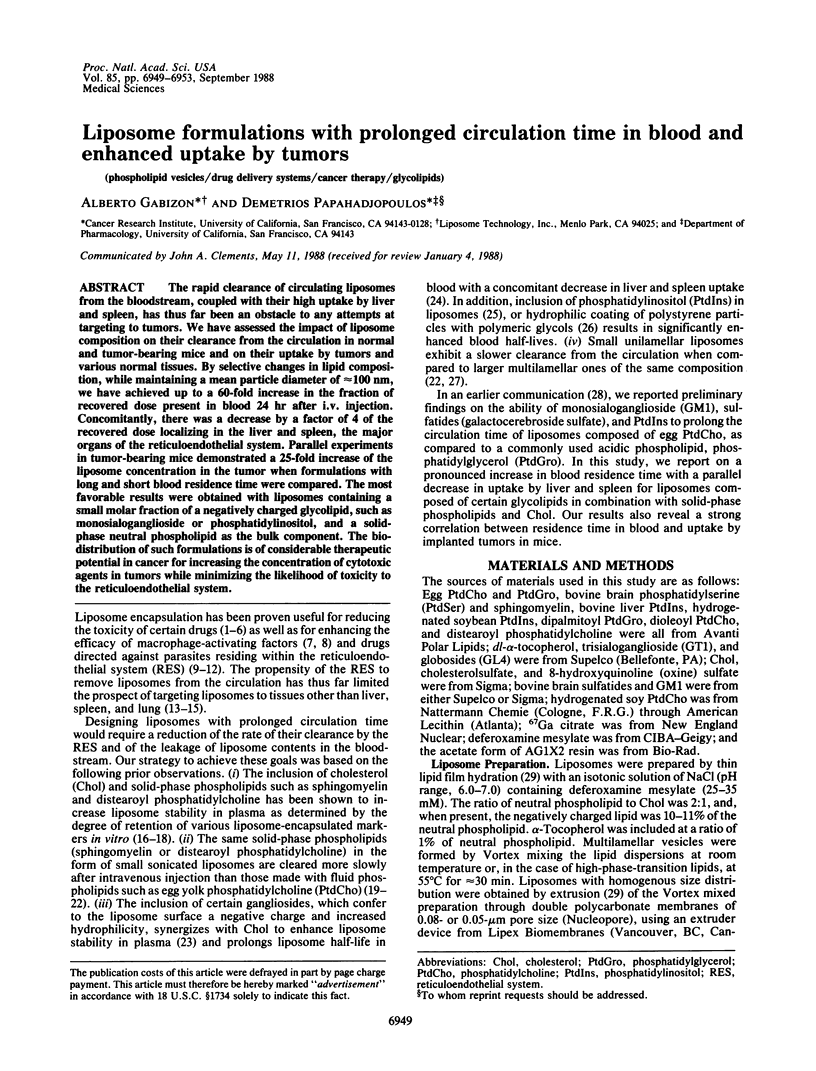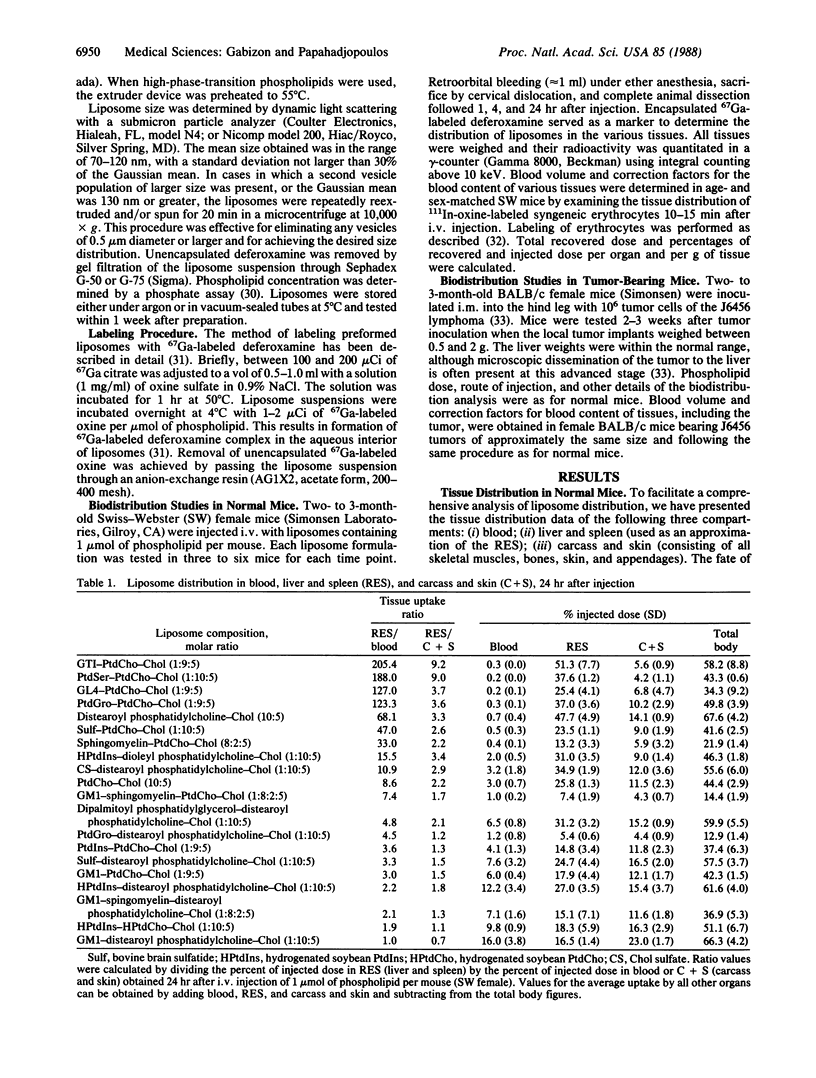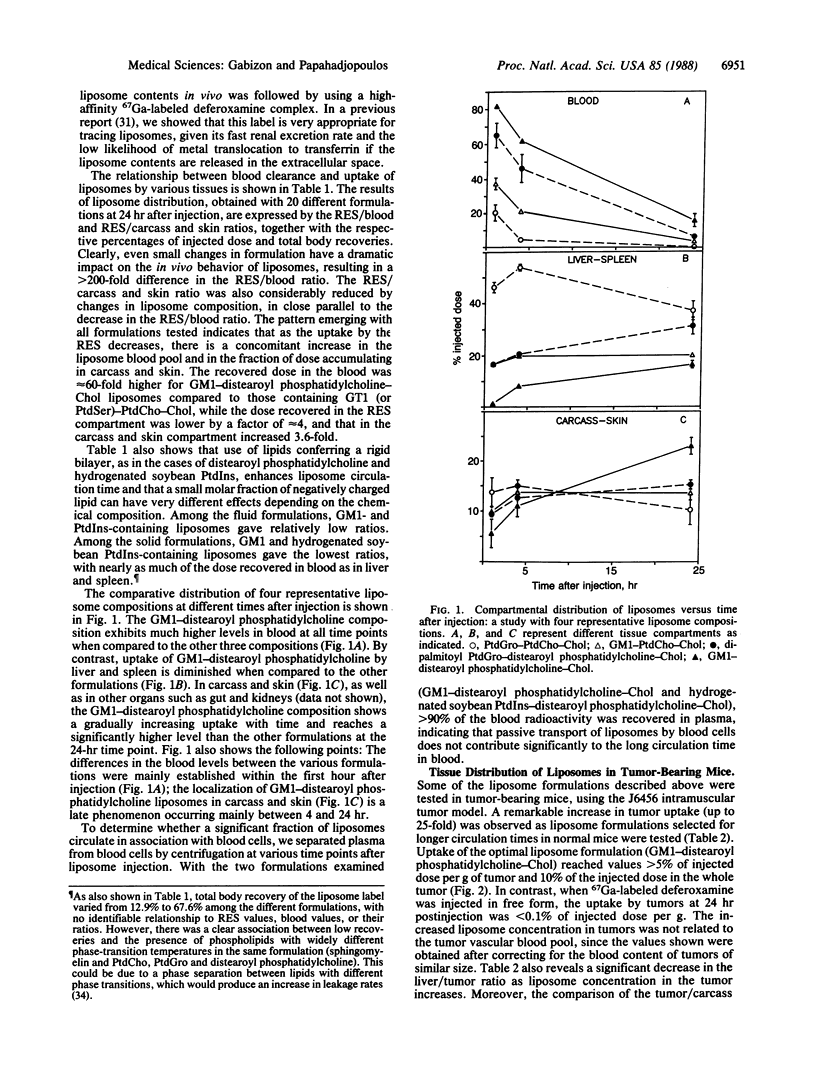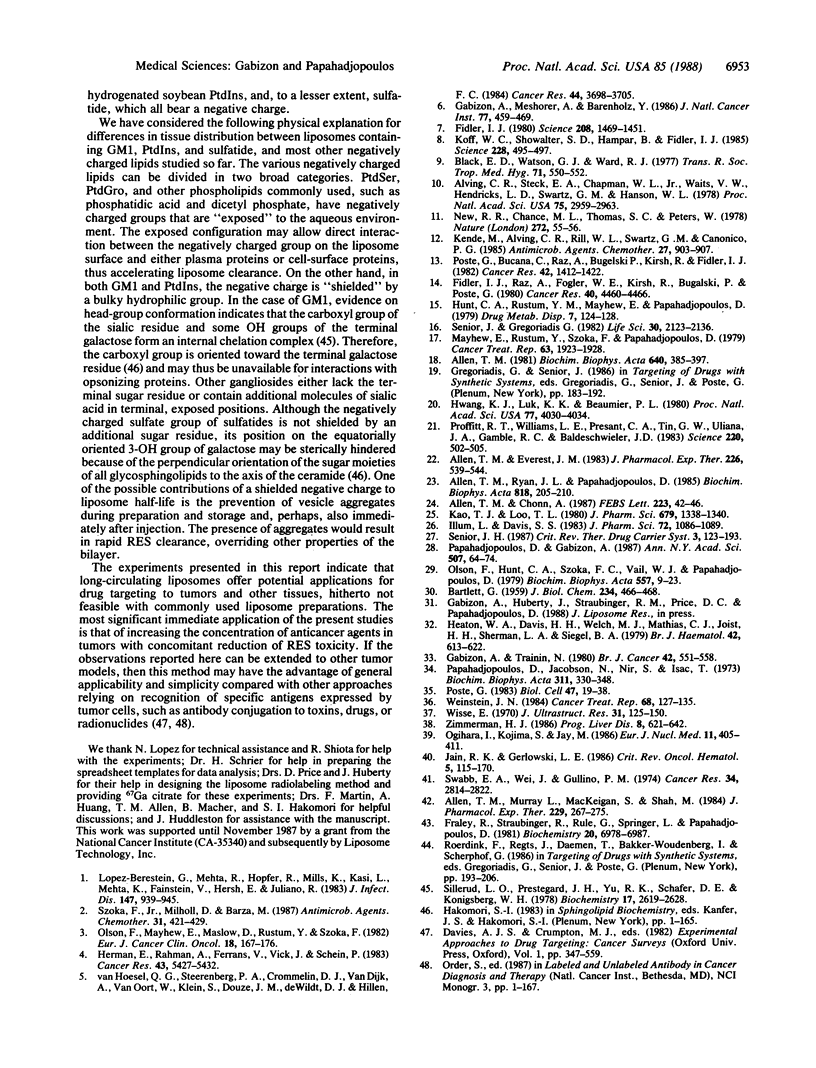Abstract
The rapid clearance of circulating liposomes from the bloodstream, coupled with their high uptake by liver and spleen, has thus far been an obstacle to any attempts at targeting to tumors. We have assessed the impact of liposome composition on their clearance from the circulation in normal and tumor-bearing mice and on their uptake by tumors and various normal tissues. By selective changes in lipid composition, while maintaining a mean particle diameter of approximately equal to 100 nm, we have achieved up to a 60-fold increase in the fraction of recovered dose present in blood 24 hr after i.v. injection. Concomitantly, there was a decrease by a factor of 4 of the recovered dose localizing in the liver and spleen, the major organs of the reticuloendothelial system. Parallel experiments in tumor-bearing mice demonstrated a 25-fold increase of the liposome concentration in the tumor when formulations with long and short blood residence time were compared. The most favorable results were obtained with liposomes containing a small molar fraction of a negatively charged glycolipid, such as monosialoganglioside or phosphatidylinositol, and a solid-phase neutral phospholipid as the bulk component. The bio-distribution of such formulations is of considerable therapeutic potential in cancer for increasing the concentration of cytotoxic agents in tumors while minimizing the likelihood of toxicity to the reticuloendothelial system.
Full text
PDF




Selected References
These references are in PubMed. This may not be the complete list of references from this article.
- Allen T. M. A study of phospholipid interactions between high-density lipoproteins and small unilamellar vesicles. Biochim Biophys Acta. 1981 Jan 22;640(2):385–397. doi: 10.1016/0005-2736(81)90464-8. [DOI] [PubMed] [Google Scholar]
- Allen T. M., Chonn A. Large unilamellar liposomes with low uptake into the reticuloendothelial system. FEBS Lett. 1987 Oct 19;223(1):42–46. doi: 10.1016/0014-5793(87)80506-9. [DOI] [PubMed] [Google Scholar]
- Allen T. M., Everest J. M. Effect of liposome size and drug release properties on pharmacokinetics of encapsulated drug in rats. J Pharmacol Exp Ther. 1983 Aug;226(2):539–544. [PubMed] [Google Scholar]
- Allen T. M., Murray L., MacKeigan S., Shah M. Chronic liposome administration in mice: effects on reticuloendothelial function and tissue distribution. J Pharmacol Exp Ther. 1984 Apr;229(1):267–275. [PubMed] [Google Scholar]
- Allen T. M., Ryan J. L., Papahadjopoulos D. Gangliosides reduce leakage of aqueous-space markers from liposomes in the presence of human plasma. Biochim Biophys Acta. 1985 Aug 27;818(2):205–210. doi: 10.1016/0005-2736(85)90571-1. [DOI] [PubMed] [Google Scholar]
- Alving C. R., Steck E. A., Chapman W. L., Jr, Waits V. B., Hendricks L. D., Swartz G. M., Jr, Hanson W. L. Therapy of leishmaniasis: superior efficacies of liposome-encapsulated drugs. Proc Natl Acad Sci U S A. 1978 Jun;75(6):2959–2963. doi: 10.1073/pnas.75.6.2959. [DOI] [PMC free article] [PubMed] [Google Scholar]
- BARTLETT G. R. Phosphorus assay in column chromatography. J Biol Chem. 1959 Mar;234(3):466–468. [PubMed] [Google Scholar]
- Black C. D., Watson G. J., Ward R. J. The use of Pentostam liposomes in the chemotherapy of experimental leishmaniasis. Trans R Soc Trop Med Hyg. 1977;71(6):550–552. doi: 10.1016/0035-9203(77)90155-9. [DOI] [PubMed] [Google Scholar]
- Fidler I. J., Raz A., Fogler W. E., Kirsh R., Bugelski P., Poste G. Design of liposomes to improve delivery of macrophage-augmenting agents to alveolar macrophages. Cancer Res. 1980 Dec;40(12):4460–4466. [PubMed] [Google Scholar]
- Fidler I. J. Therapy of spontaneous metastases by intravenous injection of liposomes containing lymphokines. Science. 1980 Jun 27;208(4451):1469–1471. doi: 10.1126/science.7384789. [DOI] [PubMed] [Google Scholar]
- Fraley R., Straubinger R. M., Rule G., Springer E. L., Papahadjopoulos D. Liposome-mediated delivery of deoxyribonucleic acid to cells: enhanced efficiency of delivery related to lipid composition and incubation conditions. Biochemistry. 1981 Nov 24;20(24):6978–6987. doi: 10.1021/bi00527a031. [DOI] [PubMed] [Google Scholar]
- Gabizon A., Meshorer A., Barenholz Y. Comparative long-term study of the toxicities of free and liposome-associated doxorubicin in mice after intravenous administration. J Natl Cancer Inst. 1986 Aug;77(2):459–469. [PubMed] [Google Scholar]
- Gabizon A., Trainin N. Enhancement of growth of a radiation-induced lymphoma by T cells from normal mice. Br J Cancer. 1980 Oct;42(4):551–558. doi: 10.1038/bjc.1980.279. [DOI] [PMC free article] [PubMed] [Google Scholar]
- Heaton W. A., Davis H. H., Welch M. J., Mathias C. J., Joist J. H., Sherman L. A., Siegel B. A. Indium-III: a new radionuclide label for studying human platelet kinetics. Br J Haematol. 1979 Aug;42(4):613–622. doi: 10.1111/j.1365-2141.1979.tb01174.x. [DOI] [PubMed] [Google Scholar]
- Herman E. H., Rahman A., Ferrans V. J., Vick J. A., Schein P. S. Prevention of chronic doxorubicin cardiotoxicity in beagles by liposomal encapsulation. Cancer Res. 1983 Nov;43(11):5427–5432. [PubMed] [Google Scholar]
- Hunt C. A., Rustum Y. M., Mayhew E., Papahadjopoulos D. Retention of cytosine arabinoside in mouse lung following intravenous administration in liposomes of different size. Drug Metab Dispos. 1979 May-Jun;7(3):124–128. [PubMed] [Google Scholar]
- Hwang K. J., Luk K. F., Beaumier P. L. Hepatic uptake and degradation of unilamellar sphingomyelin/cholesterol liposomes: a kinetic study. Proc Natl Acad Sci U S A. 1980 Jul;77(7):4030–4034. doi: 10.1073/pnas.77.7.4030. [DOI] [PMC free article] [PubMed] [Google Scholar]
- Illum S. L., Davis S. S. Effect of the nonionic surfactant poloxamer 338 on the fate and deposition of polystyrene microspheres following intravenous administration. J Pharm Sci. 1983 Sep;72(9):1086–1089. doi: 10.1002/jps.2600720933. [DOI] [PubMed] [Google Scholar]
- Jain R. K., Gerlowski L. E. Extravascular transport in normal and tumor tissues. Crit Rev Oncol Hematol. 1986;5(2):115–170. doi: 10.1016/s1040-8428(86)80023-3. [DOI] [PubMed] [Google Scholar]
- Kao Y. J., Loo T. L. Pharmacological disposition of negatively charged phospholipid vesicles in rats. J Pharm Sci. 1980 Nov;69(11):1338–1340. doi: 10.1002/jps.2600691126. [DOI] [PubMed] [Google Scholar]
- Kende M., Alving C. R., Rill W. L., Swartz G. M., Jr, Canonico P. G. Enhanced efficacy of liposome-encapsulated ribavirin against Rift Valley fever virus infection in mice. Antimicrob Agents Chemother. 1985 Jun;27(6):903–907. doi: 10.1128/aac.27.6.903. [DOI] [PMC free article] [PubMed] [Google Scholar]
- Koff W. C., Showalter S. D., Hampar B., Fidler I. J. Protection of mice against fatal herpes simplex type 2 infection by liposomes containing muramyl tripeptide. Science. 1985 Apr 26;228(4698):495–497. doi: 10.1126/science.2984772. [DOI] [PubMed] [Google Scholar]
- Lopez-Berestein G., Mehta R., Hopfer R. L., Mills K., Kasi L., Mehta K., Fainstein V., Luna M., Hersh E. M., Juliano R. Treatment and prophylaxis of disseminated infection due to Candida albicans in mice with liposome-encapsulated amphotericin B. J Infect Dis. 1983 May;147(5):939–945. doi: 10.1093/infdis/147.5.939. [DOI] [PubMed] [Google Scholar]
- Mayhew E., Rustum Y. M., Szoka F., Papahadjopoulos D. Role of cholesterol in enhancing the antitumor activity of cytosine arabinoside entrapped in liposomes. Cancer Treat Rep. 1979 Nov-Dec;63(11-12):1923–1928. [PubMed] [Google Scholar]
- New R. R., Chance M. L., Thomas S. C., Peters W. Antileishmanial activity of antimonials entrapped in liposomes. Nature. 1978 Mar 2;272(5648):55–56. doi: 10.1038/272055a0. [DOI] [PubMed] [Google Scholar]
- Ogihara I., Kojima S., Jay M. Tumor uptake of 67Ga-carrying liposomes. Eur J Nucl Med. 1986;11(10):405–411. doi: 10.1007/BF00261406. [DOI] [PubMed] [Google Scholar]
- Olson F., Hunt C. A., Szoka F. C., Vail W. J., Papahadjopoulos D. Preparation of liposomes of defined size distribution by extrusion through polycarbonate membranes. Biochim Biophys Acta. 1979 Oct 19;557(1):9–23. doi: 10.1016/0005-2736(79)90085-3. [DOI] [PubMed] [Google Scholar]
- Olson F., Mayhew E., Maslow D., Rustum Y., Szoka F. Characterization, toxicity and therapeutic efficacy of adriamycin encapsulated in liposomes. Eur J Cancer Clin Oncol. 1982 Feb;18(2):167–176. doi: 10.1016/0277-5379(82)90060-8. [DOI] [PubMed] [Google Scholar]
- Papahadjopoulos D., Gabizon A. Targeting of liposomes to tumor cells in vivo. Ann N Y Acad Sci. 1987;507:64–74. doi: 10.1111/j.1749-6632.1987.tb45792.x. [DOI] [PubMed] [Google Scholar]
- Papahadjopoulos D., Jacobson K., Nir S., Isac T. Phase transitions in phospholipid vesicles. Fluorescence polarization and permeability measurements concerning the effect of temperature and cholesterol. Biochim Biophys Acta. 1973 Jul 6;311(3):330–348. doi: 10.1016/0005-2736(73)90314-3. [DOI] [PubMed] [Google Scholar]
- Poste G., Bucana C., Raz A., Bugelski P., Kirsh R., Fidler I. J. Analysis of the fate of systemically administered liposomes and implications for their use in drug delivery. Cancer Res. 1982 Apr;42(4):1412–1422. [PubMed] [Google Scholar]
- Proffitt R. T., Williams L. E., Presant C. A., Tin G. W., Uliana J. A., Gamble R. C., Baldeschwieler J. D. Liposomal blockade of the reticuloendothelial system: improved tumor imaging with small unilamellar vesicles. Science. 1983 Apr 29;220(4596):502–505. doi: 10.1126/science.6836294. [DOI] [PubMed] [Google Scholar]
- Senior J. H. Fate and behavior of liposomes in vivo: a review of controlling factors. Crit Rev Ther Drug Carrier Syst. 1987;3(2):123–193. [PubMed] [Google Scholar]
- Senior J., Gregoriadis G. Stability of small unilamellar liposomes in serum and clearance from the circulation: the effect of the phospholipid and cholesterol components. Life Sci. 1982 Jun 14;30(24):2123–2136. doi: 10.1016/0024-3205(82)90455-6. [DOI] [PubMed] [Google Scholar]
- Sillerud L. O., Prestégard J. H., Yu R. K., Schafer D. E., Konigsberg W. H. Assignment of the 13C nuclear magnetic resonance spectrum of aqueous ganglioside GM1 micelles. Biochemistry. 1978 Jun 27;17(13):2619–2628. doi: 10.1021/bi00606a025. [DOI] [PubMed] [Google Scholar]
- Swabb E. A., Wei J., Gullino P. M. Diffusion and convection in normal and neoplastic tissues. Cancer Res. 1974 Oct;34(10):2814–2822. [PubMed] [Google Scholar]
- Szoka F. C., Jr, Milholland D., Barza M. Effect of lipid composition and liposome size on toxicity and in vitro fungicidal activity of liposome-intercalated amphotericin B. Antimicrob Agents Chemother. 1987 Mar;31(3):421–429. doi: 10.1128/aac.31.3.421. [DOI] [PMC free article] [PubMed] [Google Scholar]
- Weinstein J. N. Liposomes as drug carriers in cancer therapy. Cancer Treat Rep. 1984 Jan;68(1):127–135. [PubMed] [Google Scholar]
- Wisse E. An electron microscopic study of the fenestrated endothelial lining of rat liver sinusoids. J Ultrastruct Res. 1970 Apr;31(1):125–150. doi: 10.1016/s0022-5320(70)90150-4. [DOI] [PubMed] [Google Scholar]
- Zimmerman H. J. Hepatotoxic effects of oncotherapeutic agents. Prog Liver Dis. 1986;8:621–642. [PubMed] [Google Scholar]
- van Hoesel Q. G., Steerenberg P. A., Crommelin D. J., van Dijk A., van Oort W., Klein S., Douze J. M., de Wildt D. J., Hillen F. C. Reduced cardiotoxicity and nephrotoxicity with preservation of antitumor activity of doxorubicin entrapped in stable liposomes in the LOU/M Wsl rat. Cancer Res. 1984 Sep;44(9):3698–3705. [PubMed] [Google Scholar]


